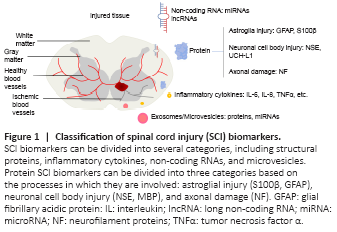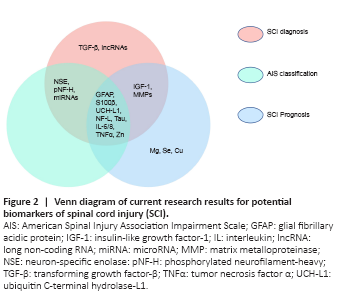脊髓损伤
-
Figure 1|Classification of spinal cord injury (SCI) biomarkers.

During SCI, neuronal and glial cell damage results in the release of cellular components into the CSF and peripheral circulation through the ruptured blood-spinal cord barrier. The concentrations of these cellular components change over time, making them potentially useful indicators of the severity of SCI and recovery prognosis. Protein biomarkers can conventionally be divided into structural and inflammation-related biomarkers (Kwon et al., 2019). The different pathophysiological processes involved in producing these biomarkers include astroglial injury (S100 calcium-binding protein β, S100β; glial fibrillary acidic protein, GFAP), neuronal cell-body damage (neuron-specific enolase, NSE; ubiquitin C-terminal hydrolase-L1, UCH-L1), axonal damage (neurofilament proteins, NF; myelin basic protein, MBP), and dendritic damage (microtubule-associated protein) (Wang et al., 2018) (Figure 1). Based on the current research results, we divided protein biomarkers into (1) biomarkers related to the diagnosis of SCI, (2) biomarkers related to American Spinal Injury Association (ASIA) Impairment Scale (AIS) classification, and (3) biomarkers related to the prognosis of SCI. We have summarized and discussed the biomarkers in each category, with the aim of identifying two or three biomarkers or their combinations with the greatest clinical potential (Table 1).
Figure 2|Venn diagram of current research results for potential biomarkers of spinal cord injury (SCI).

According to the current summary, GFAP, S100β, UCH-L1, NF-L, tau, IL-6/8, TNFα, and Zn could be useful diagnostic and prognostic biomarkers, and indicators of AIS classification in SCI; NSE, pNF-H, and miRNAs have possible roles in the diagnosis and severity assessment of SCI; IGF-1 and MMPs may be involved in the diagnosis and neurological recovery of SCI; TGF-β and lncRNAs are only useful for the recognition of SCI; and Mg, Se, and Cu are mainly related to the prognosis of SCI (Figure 2).